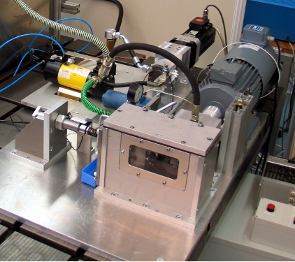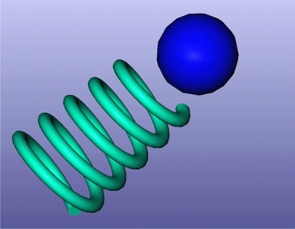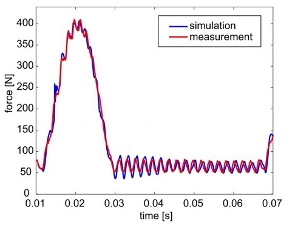Closely linked to the fundamental research at the Institute of Applied Mechanics is the simulation und validation of springs.
Classical multibody models mainly consist of rigid bodies connected with massless connections (uni- and bilateral). Springs are normally modeled with their stiffness and damping, which denotes their static behavior. But in numerous cases this approach is not sufficient, especially in highly dynamic simulations. In highly dynamic cases the dynamic of the spring itself (eigenfrequencies, overall dynamic) must also be considered, because the static and dynamic behavior is different.
Modern springs are characterized by a nonlinear behavior that is mainly caused by a non-constant pitch of the spring. Aim of the research topic is to generate a highly efficient spring model that is characterized by a low numerical effort and a high accuracy. In addition to that, the simulation results are validated with experimental data.
Basically three models for springs are currently used in multibody simulations. The multi-mass-model, the modal-model and models based on continuous beam elements. At the Institute of Applied Mechanics an efficient spring model based on a curved beam is used.
The interaction between the adjacent coils is modeled by means of non-smooth mechanics. The main advantages are that a penetration of the coils is avoided and that the contact modeling is physical motivated (non-smooth contacts are considered as fully plastic impacts).
Simulations are only useful if the results are validated with experimental data. For this reason different test rigs are used at the Institute of Applied Mechanics. Beside small test rigs for static validations and decay processes, a well-engineered test rig for dynamic experiments exists. Mainly two types of excitations can be generated with this test rig. On the one hand harmonic excitations up to about 3000 Hz to validate the eigenfrequencies and on the other hand nearly arbitrary excitations such as cam-excitations to validate the operating performance.
The efficiency and accuracy of the model has already been proved within different projects. To further improve the methodology modern numeric optimization methods are investigated for identifying the unknown parameter of the simulation such as damping parameters. Due to ever increasing numbers of CPU-cores in modern computers, these simulations can be done parallel.


